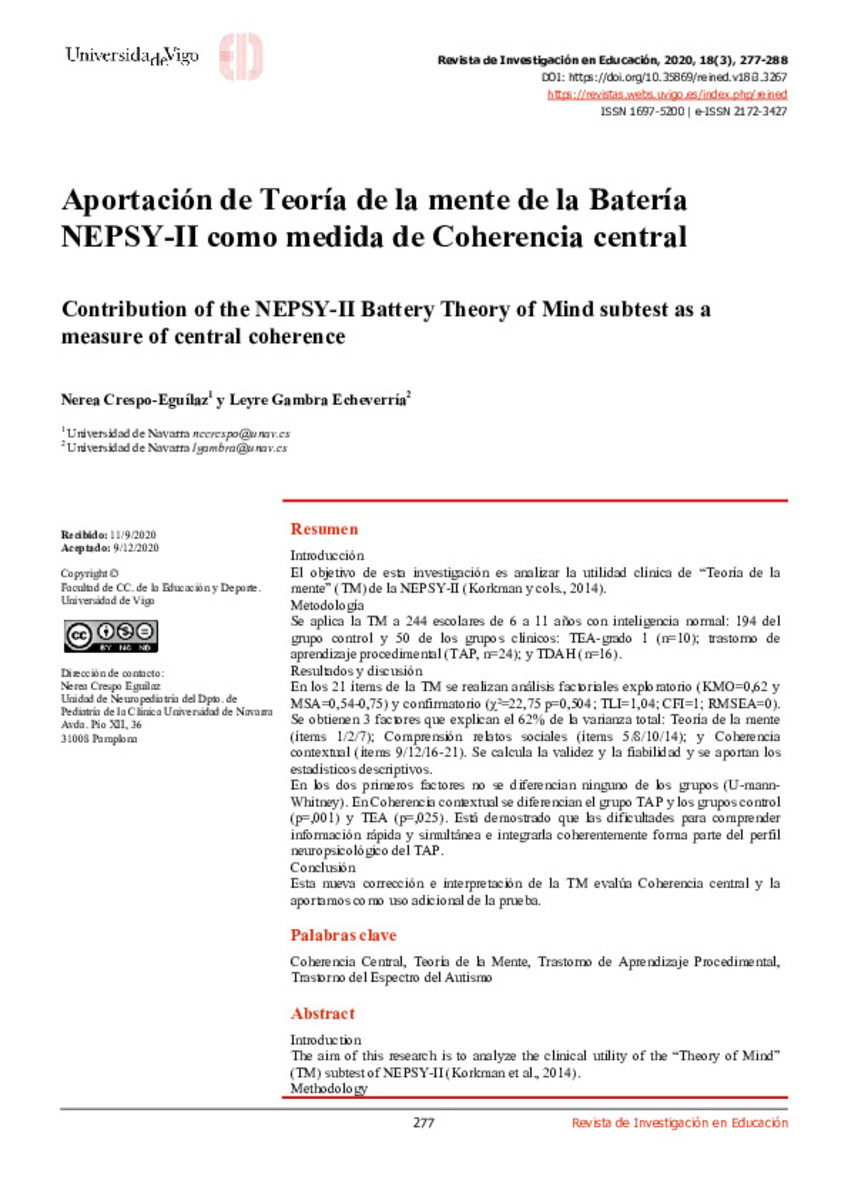Full metadata record
| DC Field | Value | Language |
|---|---|---|
| dc.creator | Crespo-Eguilaz, N. (Nerea) | - |
| dc.creator | Gambra-Echeverría, L. (Leyre) | - |
| dc.date.accessioned | 2023-02-06T07:36:43Z | - |
| dc.date.available | 2023-02-06T07:36:43Z | - |
| dc.date.issued | 2020 | - |
| dc.identifier.citation | Crespo-Eguilaz, N. (Nerea); Gambra-Echeverría, L. (Leyre). "Aportación de Teoría de la mente de la Batería NEPSY-II como medida de Coherencia central". Revista de Investigación en Educación. 18 (3), 2020, 277 - 288 | es_ES |
| dc.identifier.issn | 1697-5200 | - |
| dc.identifier.uri | https://hdl.handle.net/10171/65269 | - |
| dc.description.abstract | Introducción El objetivo de esta investigación es analizar la utilidad clínica de “Teoría de la mente” (TM) de la NEPSY-II (Korkman y cols., 2014). Metodología Se aplica la TM a 244 escolares de 6 a 11 años con inteligencia normal: 194 del grupo control y 50 de los grupos clínicos: TEA-grado 1 (n=10); trastorno de aprendizaje procedimental (TAP, n=24); y TDAH (n=16). Resultados y discusión En los 21 ítems de la TM se realizan análisis factoriales exploratorio (KMO=0,62 y MSA=0,54-0,75) y confirmatorio (χ²=22,75 p=0,504; TLI=1,04; CFI=1; RMSEA=0). Se obtienen 3 factores que explican el 62% de la varianza total: Teoría de la mente (ítems 1/2/7); Comprensión relatos sociales (ítems 5/8/10/14); y Coherencia contextual (ítems 9/12/16-21). Se calcula la validez y la fiabilidad y se aportan los estadísticos descriptivos. En los dos primeros factores no se diferencian ninguno de los grupos (U-mannWhitney). En Coherencia contextual se diferencian el grupo TAP y los grupos control (p=,001) y TEA (p=,025). Está demostrado que las dificultades para comprender información rápida y simultánea e integrarla coherentemente forma parte del perfil neuropsicológico del TAP. Conclusión Esta nueva corrección e interpretación de la TM evalúa Coherencia central y la aportamos como uso adicional de la prueba. | es_ES |
| dc.description.abstract | Introduction The aim of this research is to analyze the clinical utility of the “Theory of Mind” (TM) subtest of NEPSY-II (Korkman et al., 2014). Methodology TM was applied to 244 school aged children with normal intelligence: a control group (n=194) and clinical groups (n=50): ASD-grade 1 (n= 10); procedural learning disorder (PLD, n=24); and ADHD (n=16). Results and Discussion We do a examination of the factorial structure through a exploratory (KMO=0.62 and MSA=0,54-0,75) and confirmatory (χ =22,75 p=0,504; TLI=1,04; CFI=1; RMSEA=0) analyses. The 21 items of the TM. 3 factors are obtained that explain 62% of the total variance: Theory of mind (items 1/2/7); Social stories comprehension (items 5/8/10/14) and Contextual coherence (items 9/12 / 16-21). The descriptive statistics are provided from the calculation of validity and reliability. None of the groups differ in the first two factors (U-mann-Whitney). In Contextual coherence, the PLD group and the control groups (p=,001) differed significantly of the ASD group (p=,025). The difficulties in understanding information in a quick and simultaneous way and integrating it coherently have been shown to be part of the neuropsychological profile of the PLD. Conclusión Our study provide a new correction an interpretation of the TM that evalautes Central coherence. | es_ES |
| dc.language.iso | spa | es_ES |
| dc.publisher | Universidad de Vigo | es_ES |
| dc.rights | info:eu-repo/semantics/openAccess | es_ES |
| dc.subject | Coherencia Central | es_ES |
| dc.subject | Teoría de la Mente | es_ES |
| dc.subject | Trastorno de Aprendizaje Procedimental | es_ES |
| dc.subject | Trastorno del Espectro del Autismo | es_ES |
| dc.subject | Central Coherence | es_ES |
| dc.subject | Theory of Mind | es_ES |
| dc.subject | Procedural Learning Disorder | es_ES |
| dc.subject | Autism Spectrum Disorder | es_ES |
| dc.title | Aportación de Teoría de la mente de la Batería NEPSY-II como medida de Coherencia central | es_ES |
| dc.title.alternative | Contribution of the NEPSY-II Battery Theory of Mind subtest as a measure of central coherence | es_ES |
| dc.type | info:eu-repo/semantics/article | es_ES |
| dc.description.note | Licencia Creative Commons CC BY-NC-ND 4.0 | es_ES |
| dc.identifier.doi | 10.35869/reined.v18i3.3267 | - |
| dadun.citation.endingPage | 288 | es_ES |
| dadun.citation.number | 3 | es_ES |
| dadun.citation.publicationName | Revista de Investigación en Educación | es_ES |
| dadun.citation.startingPage | 277 | es_ES |
| dadun.citation.volume | 18 | es_ES |
Files in This Item:
Statistics and impact
Items in Dadun are protected by copyright, with all rights reserved, unless otherwise indicated.






